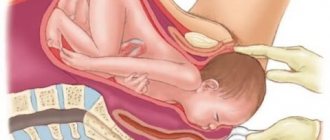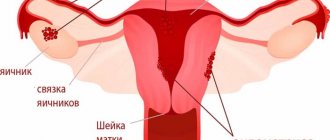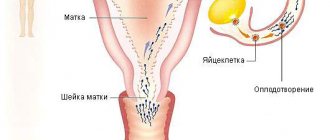You need to know them in order to avoid many diseases and be able to plan such important events as pregnancy and childbirth.
Lochia and menstruation: what is what
Many women call bloody discharge with clots after childbirth menstruation. However, they have a different nature, name and are not menstruation.
The beginning of the recovery process after childbirth is marked by lochia
Lochia after childbirth
To understand the difference between postpartum discharge and menstruation, it is necessary to understand the physiological process of restoration of the uterus after the birth of a child. Regardless of the method of delivery - natural or surgical (caesarean section), the uterus is a bleeding wound. This is due to the fact that the placenta is torn away from the reproductive organ, thereby rupturing many vessels that connected it to the uterus. In addition, from the body of the uterus itself, due to the action of the hormone oxytocin, which provokes uterine contractions, part of the fibers is separated, which leads to the restoration of its pre-pregnancy state. All this leads to the fact that the young mother observes bloody discharge with clots, gradually decreasing in volume - lochia. The average time for their completion, that is, healing of the uterus, is up to 40 days after birth.
This is interesting. The first week of lochia helps the uterus “lose weight” from a kilogram to 300 grams. In 1.5–2 months, the reproductive organ returns to an average weight of 70 grams.
The intensity of lochia must be monitored very carefully, as this is an important indicator of normal recovery of the body.
Period
Menstruation (regula) is a physiological phenomenon that represents the rejection of the mucous surface of the female reproductive organ, which occurs under the influence of a woman’s hormonal background. The menstrual cycle is determined by the work of the endocrine system, so without understanding its essence, it is difficult to understand the mechanism of the arrival of menstruation.
Table: phases of the menstrual cycle
| Phase | Deadlines | What's happening | Result |
| First (follicular) | Two weeks from the first day of your last period | Follicles (components of the egg) develop. | 1–2 dominant follicles stand out and grow. |
| Second (ovulatory) | Days 14–16 of the cycle | The walls of the follicle rupture, from which a mature egg emerges. | Ovulation occurs, meaning the woman can become pregnant. |
| Third (luteal) | 13–14 days from ovulation | The uterus is preparing for the implantation of a fertilized egg. If it does not occur, then the inner mucous membrane swells and the tissue begins to die. | Your period begins. |
This is interesting. All three phases of the monthly cycle occur under the influence of specific hormones: ovulatory under the influence of estradiol, luteal under the influence of progesterone.
Each phase occurs on certain days of the cycle
Video: ovulation after childbirth
What do we have to do?
Periods twice a month, like other changes in the menstrual cycle, are not always a sign of poor health. If this happened once, and then the cycle returned to its usual rhythm, then, most likely, there was simply a hormonal imbalance. However, this does not mean that such a situation can be ignored.
If you had unprotected sex before your period began, then before visiting the doctor you should use a home rapid pregnancy test. Perhaps extraordinary menstruation is associated with it.
In addition to the usual examination, the doctor will prescribe tests for you, including the presence of chorionic hormone in the blood, and will also conduct an ultrasound examination and hormonal analysis. Based on them, the specialist will find out the cause of the failure and select the necessary therapy.
Even if the result of a visit to the doctor is a serious diagnosis, do not despair. Proper and timely treatment will help prevent serious consequences and restore health.
First period after childbirth
Based on the mechanism of the onset of menstruation and the nature of lochia, we come to the conclusion that these are two different processes, although both are characterized by bloody discharge. The end of lochia is by no means a signal for the beginning of full menstruation. The fact is that their arrival is due to a number of accompanying factors.
During lactation, a woman actively produces prolactin, a hormone that, in turn, ensures the production of breast milk, but at the same time inhibits the hormones responsible for preparing a woman for pregnancy. It turns out that as long as there is a lot of prolactin, a young mother may not wait for her period. However, this conclusion can be challenged by citing several arguments related to individual hormonal characteristics, as well as taking into account:
- hereditary factor (of course, you shouldn’t expect a complete coincidence in the timing of the onset of menstruation after childbirth for mother, grandmother and daughter, but there won’t be strong differences in timing either);
- the presence of pathologies (the resumption of menstruation due to inflammation, a history of infectious diseases is difficult to predict);
- type and duration of breastfeeding.
The last factor is worth considering in detail.
Prolactin, produced during lactation, is responsible for inhibition of ovulation and absence of menstruation.
Resumption of menstruation during breastfeeding
The production of prolactin decreases with the introduction of complementary feeding and supplementation into the child’s diet. That is, based on the experience of the last few years, when pediatricians began to recommend complementary feeding from 4–6 months, we can say that this period is the starting point for waiting for menstruation.
This is interesting. For some women, even taking into account complementary feeding, but maintaining partial breastfeeding (especially at night, when prolactin production is faster), menstruation may not come until complete weaning.
Menstruation during artificial feeding
In this situation, prolactin is not produced in large quantities, so the completion of lochia and the healing of the uterus is the time for the onset of menstruation. This usually happens 1.5 months after birth. But the absence of menstruation for 4–5 months is not considered a deviation. In situations where lactation has been completed for some reason, the regulation will be restored after prolactin begins to be produced prenatally.
This is interesting. A woman who does not have her period after 4–5 months from the end of postpartum discharge needs to consult a gynecologist.
With artificial feeding, menstruation begins earlier
Regulations for combining breastfeeding and artificial feeding
If the baby receives both mother's milk and formula, menstruation comes after 3-12 months. The large range is associated with the time of day at which the number of feedings is reduced: if in the morning and evening, when prolactin is produced most actively, then menstruation will begin earlier.
Video: restoration of menstruation after childbirth
Postpartum period and onset of menstruation
After the birth of a child, all systems of a woman’s body begin to slowly recover - this period is called the postpartum period. It lasts more than one month - on average, from 6 to 8, depending on the course of pregnancy and the individual characteristics of each woman.
The organ that has undergone the most noticeable changes during pregnancy is the uterus.
But despite this, the recovery process occurs surprisingly quickly and actively. In the first month after birth, the transverse size of the uterus is 12 centimeters, and the weight is one kilogram. After just two weeks, she loses 50% of her postpartum weight, and after a month, maximum two, she recovers completely.
In non-breastfeeding mothers, i.e. if the baby is only on artificial nutrition, the menstrual cycle stabilizes, as a rule, by 6 weeks. 95% of women who breastfeed do not have a period until 6 months or throughout the entire period of breastfeeding. When the menstrual cycle is restored, 20% of women in labor experience menstruation, occurring 2 times a month (not to be confused with intrauterine bleeding!).
This is explained by the slow adjustment of hormonal regulation mechanisms - “trial and error”, that is, gland cells restore temporarily lost contacts and reactions to them. During stabilization, they release active substances more often than necessary, and this leads to hormonal disruptions at different stages and causes menstruation that comes more often than once a month.
The process of establishing the menstrual cycle is a purely individual matter.
It is a mistaken assumption that after childbirth the formation of an egg does not occur for some time. In women who have recently given birth, the egg is formed normally, but when it reaches the ovulatory phase of the cycle, it does not leave the ovary. The follicle undergoes a reverse, involutional process, but the corpus luteum does not develop. And 2, less often 3 times, such “incomplete” cycles occur, after which menstruation is restored.
Features of the first menstruation: symptoms, nature of discharge and timing
The main fear of women expecting their first period after childbirth is that it will start suddenly. In fact, in most (!) cases, premenstrual syndrome (PMS) cannot be avoided, so the “readiness signals No. 1” will be:
- nagging pain in the lower abdomen;
- mood swings;
- headache.
Before the first period after childbirth, a woman may experience increased PMS.
Another important point that you need to prepare for in advance is a possible change in the nature of the discharge. After childbirth they may become:
- more painful;
- more abundant or more scanty compared to those before pregnancy;
- with clots (usually such lumps are characteristic of menstruation, which began shortly after the completion of lochia, and these inclusions are the remains of damaged tissue and fibers, indicating that the endometrium is still recovering).
As for the timing of the first menstruation, they may be a little longer or, conversely, a little shorter. In general, monthly bleeding in the absence of abnormalities should not last longer than 7–8 days. In this case, the first few cycles will be within 21–30 days, then the timing will be adjusted.
This is interesting. The resumption of menstruation after a cesarean section occurs in the same way as after a natural birth. After an abortion or miscarriage, the cycle returns depending on the woman’s health condition, as well as the presence of complications after curettage.
Possible troubles
Let's move on to considering possible deviations or complications that young mothers may encounter when restoring their normal menstrual cycle:
- Regularity. After the birth of the baby, periods may resume their regularity immediately, but it is possible that the process will take 2-3 times longer. If the normal rhythm is not restored after six months, there is a need to see a doctor in the next month.
- Duration. Typically, periods and their cycle stabilize after childbirth. For example, if before childbirth the cycle was 23 - 30 days, then you can almost certainly expect the formation of a 26 - 27 day cycle. Normally, menstruation lasts 3 - 5 days. If they are less than 2 days or, conversely, more than 6, then there is reason to think about the presence of some pathology - endometriosis (when the endometrium of the uterus forms in atypical places of the female genital tract) or fibroids (a benign tumor).
- The volume of menstrual flow is usually 50 ml. A threefold increase in volume is permissible. A noticeable decrease or increase in this indicator most often indicates the presence of a gynecological disease in a woman. But here we need to make allowances for the gradual postpartum restoration of this function and allow for reasonable deviations in indicators.
- Soreness. When the uterus returns to its previous size, a pulling or shooting sensation is felt in the lower abdomen. They vary in severity for each woman. But the next time you see a doctor, you must inform him about these sensations.
- The presence of unusual impurities in menstrual flow after childbirth. The process of giving birth to a child and the “hormonal explosion” is a great stress for the mother’s body, often leading to exacerbation of chronic infections (endometritis, salpingo-oophoritis, etc.). They cause slight deviations from how menstruation usually proceeds.
- Delayed periods or increased frequency. As a result, with serious hormonal changes, for some time, uncharacteristic behavior of the pituitary gland (the gland at the base of the brain) may occur in the form of increased or inhibited hormone release. These highly active substances, acting on the ovaries, lead to disruption of the development of follicles and thereby lead to the fact that menstruation becomes irregular and can come 2 times a month.
After the birth of the baby, the load on the hormonal and nervous system increases.
With the beginning of breastfeeding, the need for vitamins, microelements and minerals, which the body needs for the proper functioning of all organs and systems, increases significantly. Therefore, in addition to good nutrition, it is recommended to take multivitamins with a set of microelements selected by your doctor specifically for nursing mothers. This may help prevent some problems, such as getting periods twice after giving birth.
When to be alarmed
There are several reasons associated with the resumption of menstruation that require prompt consultation with a doctor. It is worth noting that it is impossible to draw conclusions about deviations after the first menstruation. The only exceptions are heavy bleeding or unbearable pain . To get an objective picture, you need to monitor your health for 2–3 cycles.
This is interesting. Despite the absence of menstruation, after the end of lochia, a woman can become pregnant again. This, again, is due to the individual characteristics of her body, so it is worth paying attention to the choice of contraception. It is worth considering that if an intrauterine device is chosen, then the first menstruation may be longer, heavier and more painful, and if birth control pills are used, then, on the contrary, the discharge will become short-lived, scanty, and sometimes even spotting.
The duration and intensity of menstruation is also affected by the method of contraception.
Prolonged and heavy discharge
Protracted periods are those that last longer than 8 days. Often, prolonged periods are accompanied by copious discharge. If the pad has to be changed more often than 2.5–3 hours in two or more cycles, then the bleeding is considered intense. Such deviations occur especially often in women who have had a caesarean section or abortion. In addition, in this way the body signals that:
- particles of membranes remain on the walls of the uterus;
- inflammation develops;
- the woman was (or is) under stress;
- During pregnancy, the young mother suffered from iron deficiency anemia.
Conservative treatment is considered:
- hemostatic drugs;
- vitamins;
- medications that replenish iron reserves in the body.
If these means do not produce results, the woman is prescribed curettage, which has two goals: to exclude the development of tumors in the endometrium and to stop bleeding.
Periods are too fast
Common causes of accelerated menstruation (less than 2 days) are:
- sudden weight loss of a woman;
- heavy bleeding after childbirth;
- hyperprolactinemia - a strong increase in prolactin.
Menstruation less than two days is considered a deviation from the norm
Scanty periods
A spot-like discharge (in the absence of hormonal contraception) repeated for more than three cycles in a row should also raise alarm. Such a cycle disruption may indicate a hormonal imbalance, endometritis (inflammation of the lining of the uterus) or Sheehan syndrome (a neuroendocrine disorder caused by the death of pituitary cells due to complications during childbirth or abortion).
Irregular menstruation
An unstable cycle six months after the first menstruation, as well as a break of more than three months between menstruation, can be caused by:
- ovarian pathology;
- general exhaustion of the body;
- any complications after childbirth (including those caused by the use of epidural anesthesia);
- tumor in the pelvis;
- disturbances in the functioning of the endocrine system.
Menstruation twice a month
More than three cycles in a row, this phenomenon can be caused by abnormalities in the pituitary gland, which, by acting on the ovaries with hormones, provokes disturbances in the follicular phase of the cycle.
Hormonal imbalances require precise correction, so consultation with an endocrinologist is required.
Unpleasant odor, bright color, itching
A pungent odor of discharge, bright color, as well as fever, severe pain in the lower abdomen are symptoms caused by infections or oncology. Itching and cheesy discharge are signs of thrush.
Stopping menstruation after the first 1–2 cycles
In this case, first of all, you need to exclude a new pregnancy. The reason for such a stop in the physiological process may be a rather rare condition - early menopause.
This is interesting. Any alarming conditions related to women's health should be discussed with a specialist. Therefore, you should not neglect visits to the gynecologist.
Fine
The menstrual cycle is a normal physiological process for women of reproductive age. Its duration varies among women (from 21 to 35 days). Menstruation is bloody discharge that occurs under the influence of hormones. Typically, women have menstrual flow once a month, however, if a woman's menstrual cycle is only 21 days, then menstruation can occur at the beginning and end of the month.
If menstruation comes again in the middle of the cycle, this may indicate problems in the body and require treatment. Let's talk in more detail about the reasons for the appearance of menstruation twice a month.
Personal hygiene when restoring menstruation
Hygienic procedures during the resumption of menstruation after childbirth are no different from those carried out before pregnancy:
- replace the gasket at least every 4 hours;
- use of underwear made from natural fabrics;
- mandatory washing after defecation (ideally, a woman should wash herself every time before changing the pad);
- using intimate hygiene gel or baby soap, herbal infusion (some gynecologists advise not to use anything, only water, possibly adding a weak solution of manganese to eliminate bacteria);
It is advisable to wash yourself with a special gel for intimate hygiene, - refusal of a bathhouse, sauna, swimming pool - all this against the background of a slightly opened cervix (for discharge of secretions) increases the risk of infections entering a woman’s body;
- bathing in water that is not too hot, so as not to provoke increased bleeding or proliferation of microorganisms;
- if possible, avoid sexual intercourse during menstruation; if this is not possible, then obligatory washing of both partners before contact.
What should I do if my period lasts for a month or more?
If a woman does not know why her periods take so long and what could be the cause of this problem, if a woman does not know why her periods take so long, then she should definitely seek help from a doctor. Self-medication with hemostatic drugs can be very dangerous for a woman’s health. Therefore, the first thing, if your periods take a long time, when menstruation lasts 1 month, you need to find out the cause of this problem, and for this you need to seek help from a doctor and sometimes even undergo certain examinations and diagnostics. The following are the main methods of combating prolonged menstruation that are used in official medicine.
In this case, it is recommended to use minerals, vitamins, vascular strengtheners, drugs for uterine contraction and hemostatic drugs. In folk medicine, heavy menstruation is called uterine bleeding. In some cases, traditional medicine helps to cope with this kind of pathology. For example, if after the birth of the baby, menstruation cannot stop, then the cause of such four-week bleeding may be poor uterine contractions. What can traditional medicine recommend in this case? An excellent option would be nettle, a unique anti-bark remedy. It is recommended to drink nettle tea, up to two liters per day, which will not only eliminate bleeding after childbirth, but also enrich the body with vitamins and improve the composition of breast milk.
Also, if there is severe bleeding, it is recommended to use a diet based on raw soaked flaxseeds, juice from freshly squeezed plantain leaves, infusion of water pepper, and watermelon seeds. It is difficult to give a definite answer to the question why the duration of menstruation increases. In fact, such reasons may lie in the presence of a pathology or condition of the body. In order to accurately determine the cause of this phenomenon, it is recommended to carefully consult with a doctor; only he, based on all the tests and examination, can make an accurate diagnosis and prescribe treatment.
How to stabilize your periods
You should think about restoring menstruation in advance by discussing this issue with your gynecologist. Especially if there were complications during childbirth. In addition, it is worth listening to the recommendations of experts and:
- enrich the diet with foods high in vitamins and microelements;
- do a little physical exercise (swimming, yoga, Pilates);
You can do joint training with your baby - choose comfortable underwear to prevent disruption of blood microcirculation in the groin area;
- avoid stress and emotional overload;
- drink enough liquid (if this does not harm lactation, for example, when a woman plans to gradually wean her baby from the breast);
- ensure regular sex life, not forgetting about contraception.
This is interesting. Women with postpartum syndrome (depression) are recommended to drink herbal teas and light sedatives with natural ingredients. If necessary, visit a psychologist.
Video: how to help the body recover after childbirth
The duration and nature of menstruation after childbirth are determined by several factors that are individual in nature. It is important to distinguish in time the normal course of the recovery process after childbirth from pathology. To do this, a woman needs to closely monitor her health and regularly visit a gynecologist. And also do not neglect advice on stabilizing the monthly cycle.
- Author: Natalya Vasylishin
Higher philological education, 11 years of experience teaching English and Russian, love for children and an objective view of modernity are the key lines of my 31-year-old life. Strengths: responsibility, desire to learn new things and self-improvement. Rate this article:
- 5
- 4
- 3
- 2
- 1
(15 votes, average: 4.9 out of 5)
Share with your friends!
Reasons for long periods, why periods last 1 month
The main causes of long periods are very diverse. In some cases, when a woman does not know what the causes of protracted and prolonged periods are, why menstruation lasts for a very long time, in order to know what to do with prolonged menstruation, you need to determine its cause. The occurrence of repeated menstruation within one cycle or their duration can most often be caused by:
1 The use of oral hormonal contraception can lead to menstruation failure. Moreover, there may be no menstruation for 1 week, 2 weeks, 1 month or even more. Also, a delay in menstruation can turn into a very long menstruation. But it is important to remember one thing, both in case of a long delay in menstruation, and in the case when menstruation lasts 1 month, you should definitely seek help from a doctor who prescribed hormonal birth control pills;
2 If your period lasts 1 month or more, this can be explained by a hormonal imbalance. Hormonal imbalances in a woman’s body often provoke disruptions in the normal course of the menstrual cycle. In this case, menstruation can last about a month or longer. The cause of such failures is often inflammatory processes in the genital organs, the consequences of childbirth and abortion;
3 Disorders in the cycle, often found in young girls and women in the premenopausal period;
4 Installation of a hormonal IUD (intrauterine device) can lead to both a delay in menstruation and the case when menstruation does not stop for 1 month or more. This type of contraception often causes cycle disorders, in which periods last longer than a month. Under such circumstances, it is necessary to urgently contact a gynecologist for emergency removal of the IUD.
Small cycle
Ovulation is a very complex process for which the body first prepares, so new ovulation cannot occur immediately after menstruation. It takes a certain amount of time for the follicle to mature; for this reason, the first 8-10 days of the cycle are generally considered safe for pregnancy. It is on this principle that the calendar method of birth control is based.
But the female body is a very delicate mechanism that can be affected by almost any factor, so it is difficult to predict what impact a change in lifestyle or another quarrel with the boss at work will have on the range between menstruation. In theory, conception can occur on the 7-8th day of the cycle, when conditions are created for the rapid maturation of the egg, and such cases do occur, especially when the normal cycle length, due to the individual characteristics of a woman’s body, is less than 21 days.
A minimal break between periods can occur during adolescence and menopause, as well as due to hormonal imbalance. For example, when the level of progesterone increases significantly, the egg may not mature at all. The follicular phase, which usually lasts 2 weeks, can be shortened to 7 days. Most often, when the period between menstruation becomes less than 21 days, a lack of ovulation is detected. Such an anomaly can be diagnosed by ultrasound, which is performed in different phases over the course of a month.











